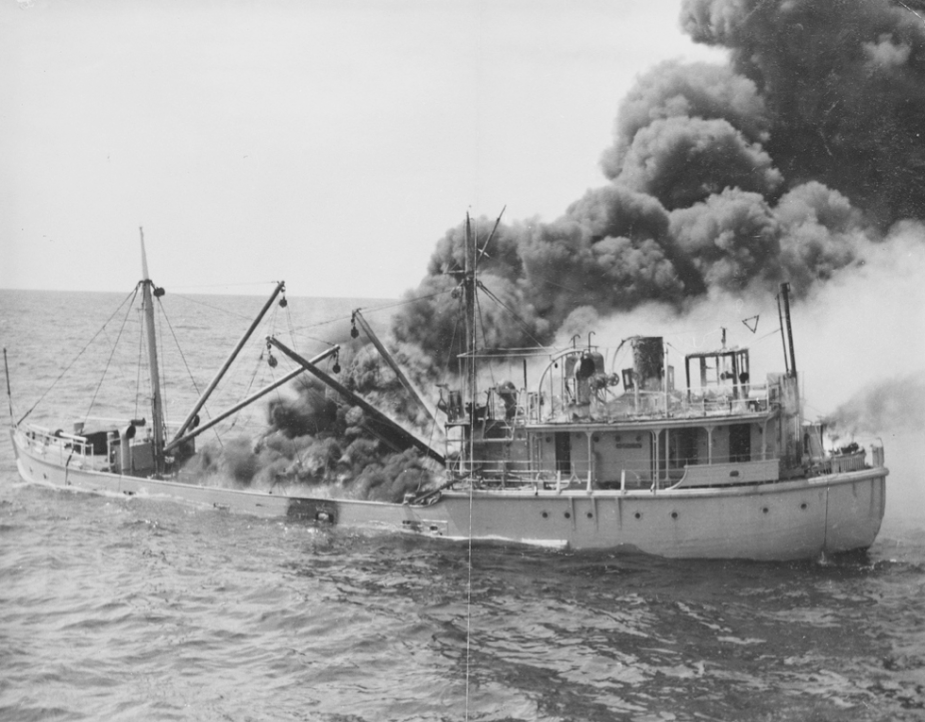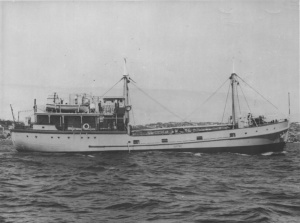Army Vessel AV 1356 (Ashburton) was completed in November 1945 in north Fremantle and was transferred to the Royal Australian Navy (RAN) at Appleton Dock in Melbourne on 23 January 1946 for service as an armament store carrier.
It commissioned as HMAS Woomera at Melbourne on 20 February 1946 under the command of Lieutenant Roy Helliar RANVR. Two ships of the same class also transferred to the RAN as HMA Ships Anaconda and Mother Snake.
Most of Woomera’s service consisted of the carriage of stores and the dumping of obsolete ammunition at sea in deep water, a practice undertaken by all 3 services until the early 1970s. It visited ports along Australia’s east and north coasts between Melbourne and Darwin, and visited Papua New Guinea on 3 occasions in December 1949, April to June 1956 and February to March 1958.
In November and December 1957, it carried RAN college equipment from Flinders Naval Depot at Crib Point, Victoria, to Jervis Bay, Australian Capital Territory, as part of Operation COLBACK, the return of the college to Jervis Bay after 27 years at Crib Point.
On 11 October 1960 an explosion occurred during an ammunition dumping operation off the New South Wales coast which started a fierce fire in Woomera’s hold. The ship sank about 90 minutes after the fire started. The ship’s executive officer, Lieutenant (later Commodore) Sam Bateman later recalled the incident:
It was a wooden ship, so once the fire took hold it burnt very quickly. The crew abandoned ship mostly with their lifejackets. The fire came up over the superstructure so there was no time to launch the lifeboats.
Lieutenant Bateman, the commanding officer, Lieutenant Commander Doug Marshall, the navigator, the chief engineer and the radio operator remained on board dumping ammunition for another 10 minutes after the rest of the crew had abandoned ship. The fire claimed the lives of 2 sailors, Able Seaman Barrie Baker and Seaman Robert Herd who were part of an attached work party and not actually part of Woomera’s crew. After spending approximately an hour in the water the 25 survivors were rescued by the frigate HMAS Quickmatch and destroyer HMS Cavendish which were exercising nearby. Quickmatch and Cavendish conducted an unsuccessful search for the 2 missing sailors before transporting the survivors to Sydney. HMAS Woomera shortly after the explosion that set it alight.
HMAS Woomera shortly after the explosion that set it alight.
Lieutenant Commander Marshall and Lieutenant Bateman were both court-martialled and found to have no case to answer. The cause of the explosion was never discovered though it is surmised that a parachute flare may have ignited when its parachute was unexpectedly deployed. The flares contained a friction igniter which was triggered by the deployment of the parachute.
Radio Operator Francis Thompson and Chief Engine Room Artificer Ray Butler were both awarded the British Empire Medal (Military) after the event. Thompson for remaining at his post and ensuring that his SOS message and the ship’s coordinates had been received while his radio room burned around him, and Butler for his courage in trying to fight the fire before Lieutenant Commander Marshall ordered him to abandon ship.
Specifications
 |
| Type |
Armament Store Carrier |
|---|---|
| Builder |
Australian Shipbuilding Board |
| Commissioned |
20 February 1946 |
| Decommissioned |
11 October 1960 |
| Fate |
Sunk due to fire onboard |
| Dimensions & Displacement | |
| Displacement | 603 tons |
| Length | 125 feet |
| Beam | 24 feet |
| Draught | 12 feet 6 inches |
| Performance | |
| Speed | 8.5 knots |
| Range | 1000 miles at 7.5 knots |
| Complement | |
| Crew | 3 officers, 17 sailors |
| Propulsion | |
| Machinery | Ruston-Hornsby diesel engines - 2 shafts |